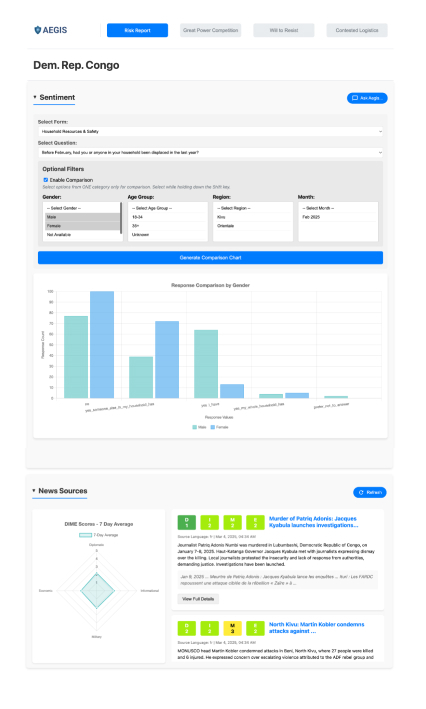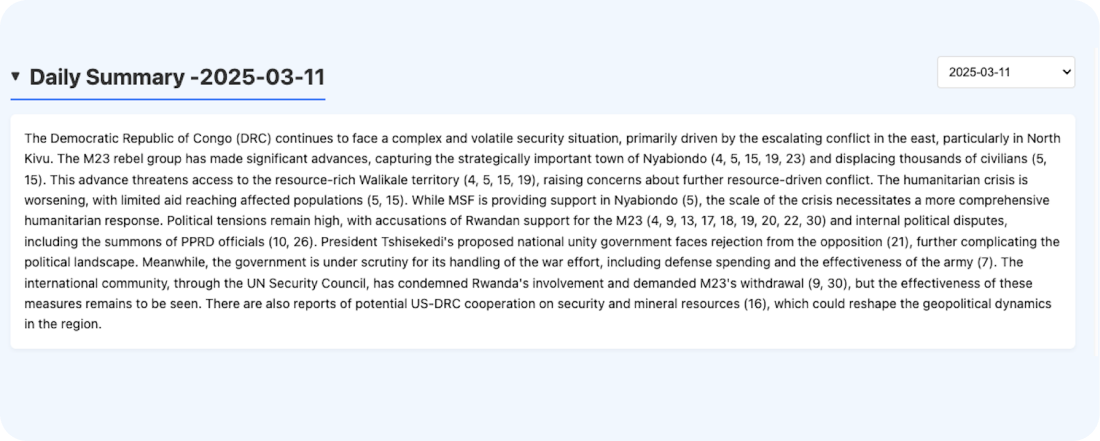- Improvements in generative AI are making it possible to fully automate or significantly reduce the time requirements for critical humanitarian data analysis and reporting.
- Humanitarians are about to run out of data – and AI is not going to be useful for long if there isn’t any data.
Most of the core humanitarian data systems were heavily funded by the US government and, so far, no donor or combination of donors has funded their replacement. This humanitarian reset means these systems are needed more than ever to help prioritize activities and maintain accountability.
Premise can solve this problem
The two most promising cost saving technologies in the humanitarian data world are remote data collection and AI. We think Premise has the premier remote data collection platform in the international development or humanitarian assistance sectors. It’s also the top platform in the consumer packaged goods industry, so we’ve been able to attract a lot of outside investment to build it. Premise has:
- The most countries and largest networks of data collectors – particularly when it comes to countries with ongoing crises
- Proven ability to collect both survey and observational data in accordance with OCHA data responsibility guidelines and using established humanitarian instruments
- A full technology stack for managing this remotely, including linkages with payment providers everywhere we operate
Additionally, for 10+ years our customers have been asking us to do things like write reports, build custom charts and graphs, analyze their data for them, and so on. Now AI can help do all those things.
This is why we’re rolling out AEGIS for Humanitarian Assistance – our fully remote, fully digital, AI-powered data collection and insights solution for humanitarian needs assessment and crisis monitoring.
We’ve been building AEGIS for generalized use cases since early last year; now that we’ve got the basics locked down we are prioritizing configuring a humanitarian version of it and self-funding initial data collection because now is the moment it’s needed most.
We also know we don’t have all the answers. Many humanitarian information management professionals have been working to improve how this data is collected, analyzed, and utilized for decades and we could never catch up to their experience.
That’s why we’ve teamed up with 3iS to help us shape and deliver AEGIS to the humanitarian community. Their experience using the latest innovation and technology offered by the private and academic sectors to enhance humanitarian information management and experience helping UN agencies, governments, and NGOs turn this information into humanitarian impact makes them the perfect partner.
Together we have a simple goal: Produce the full suite of humanitarian information management services for less than 30% of the historical cost
That’s a big task, so we’re starting with just needs assessment and crisis monitoring and are going to work our way from there towards the Humanitarian Needs Overview (HNO)/Humanitarian Response Plan (HRP) process and its key statistics. If we see good adoption, we’d love to tackle some of the large data collection programs of record, including health and famine early warning and security monitoring.
We have significant field and HQ-level interest from key humanitarian actors and are working to pilot AEGIS with them now.
If you’ve lost your funding for humanitarian information management but think another donor could pick up ~30% of the tab, shoot Premise or 3iS an email. We can help.

Back on February 25th we launched our first AI Humanitarian Situation Report, for the DRC. AEGIS used results from our survey (based on a Multisector Initial Rapid Assessment or MIRA) that we ran in mostly North and South Kivu, combined the results with real-time secondary data from all over the internet, analyzed the results, and wrote a humanitarian situation report that you can get here. It took AEGIS four minutes to produce this and took us about 8 hours to format all of the graphics, check every single statistic in the report, and edit the copy. You can read more about how AEGIS works here. We expect to get that time down for the next report!
What’s in the next version of AEGIS?
We’ve got some big changes coming for the next version of AEGIS.
- Countries. We will run the second month of DRC data collection and add Yemen and Ukraine. We have strong interest from humanitarian actors in those countries so they made it into the next wave.
- Surveys. 3iSolution has improved the MIRA-like assessment we were using and helped us design our first 2 cluster surveys! The next AEGIS surveys, which will launch on Monday March 17th, will include separate surveys on health and food security, in addition to the MIRA.
- Assistant. AEGIS’s built-in Assistant, which lets users analyze their survey data through a prompt-based (natural language querying) interface is now producing better charts, which you’ll see in the new reports.
- Summaries. AEGIS now produces daily summaries and monthly reports. The daily summaries reflect changes in the secondary data monitoring while the monthly reports, like the first DRC one, analyze the new survey data plus the last month’s secondary data.

We’re hoping to release the next 3 reports on either April 1st or 8th.
What’s in v3?
We have big ambitions for the expansion of AEGIS over the next few months and are already hard at work. We’ll spend the 2 weeks we have allocated for data collection in DRC, Yemen, and Ukraine finishing up the efforts below if we can.
- Countries. We’re currently planning to ramp up to 10 countries. We will add them incrementally but we hope to bring Myanmar, Ethiopia, Nigeria, Venezuela, Mali, Afghanistan, and Colombia over the next 2 months. If you want to partner in one or more of these countries let us know now and we can try to get it in the next wave (April)
- Surveys. Increase the sectoral scope of the data collection to cover the MIRA-like assessment and 6 clusters: food security, health, education, WASH, protection, and nutrition. We would also be open to supporting early recovery and shelter but we need to do more research.
- Price. We know we need to show donors and implementers the math behind our <30% of the cost goal and be transparent about what you will and won’t get for the price. We’ll be able to discuss that in a couple of weeks and are speaking with some key actors about it now.
- Add-Ons. Premise’s platform is also great for market monitoring and special assessments for topics like cash and voucher assistance, winterization, and more. We can’t afford to do that without a customer, but we plan to include it in the final product.
We are brainstorming how to produce a Humanitarian Needs Overview too, but that will take more time.
The F Word
We know it’s hard to think about the future when the dust hasn’t settled yet. We are strongly in favor of funding humanitarian data streams. But, we cannot return to business as usual. The humanitarian reset means we must remake these systems for the modern era – something most humanitarian data professionals would admit needed to be done a long time ago if you caught them in a bar or in an off the record setting. Let’s do it right now.